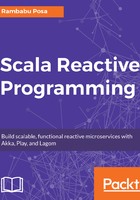
Reactive systems versus traditional systems
In this section, we will see the main differences between a Reactive system and non-Reactive system, that is, a traditional system.
The first and foremost difference is that a Reactive system takes a user or customer request as an event or message, and then reacts to those events in a timely manner. Once it's done, it continuously looks for the next event, as illustrated here:

On the other hand, a traditional system takes input(s) from a user, performs an operation based on inputs, and sends an output or response to the user; that's it:

In a Reactive system, the RP model eases the development. As a Reactive system supports abstraction at a very high level, it is easy to develop the applications because we need to concentrate on only our application business logic. Meanwhile, in a traditional system, we need to take care of the application business logic while writing some low-level logic, as it does not support high-level abstraction.
In a Reactive system, changes are propagated automatically. For instance, in a spreadsheet, we have a formula at cell A3, A3 =A1+A2. When we change the value of A1 or A2 or both, then all their references will be updated automatically. This means A3 will be updated automatically. It is not possible in a traditional system or non-Reactive system.
In Reactive systems, we concentrate on the flow of control, whereas in traditional systems, we concentrate on the flow of data.